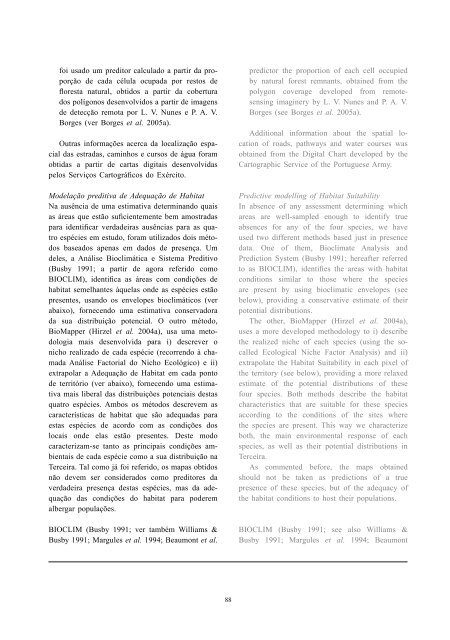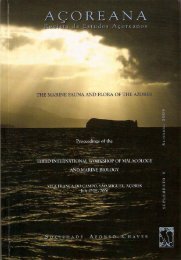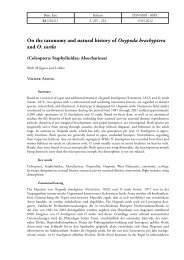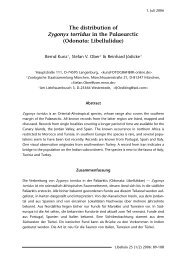(eds.) (2005). - Portal da Biodiversidade dos Açores - Universidade ...
(eds.) (2005). - Portal da Biodiversidade dos Açores - Universidade ...
(eds.) (2005). - Portal da Biodiversidade dos Açores - Universidade ...
You also want an ePaper? Increase the reach of your titles
YUMPU automatically turns print PDFs into web optimized ePapers that Google loves.
foi usado um preditor calculado a partir <strong>da</strong> proporção<br />
de ca<strong>da</strong> célula ocupa<strong>da</strong> por restos de<br />
floresta natural, obti<strong>dos</strong> a partir <strong>da</strong> cobertura<br />
<strong>dos</strong> polígonos desenvolvi<strong>dos</strong> a partir de imagens<br />
de detecção remota por L. V. Nunes e P. A. V.<br />
Borges (ver Borges et al. <strong>2005</strong>a).<br />
Outras informações acerca <strong>da</strong> localização espacial<br />
<strong>da</strong>s estra<strong>da</strong>s, caminhos e cursos de água foram<br />
obti<strong>da</strong>s a partir de cartas digitais desenvolvi<strong>da</strong>s<br />
pelos Serviços Cartográficos do Exército.<br />
Modelação preditiva de Adequação de Habitat<br />
Na ausência de uma estimativa determinando quais<br />
as áreas que estão suficientemente bem amostra<strong>da</strong>s<br />
para identificar ver<strong>da</strong>deiras ausências para as quatro<br />
espécies em estudo, foram utiliza<strong>dos</strong> dois méto<strong>dos</strong><br />
basea<strong>dos</strong> apenas em <strong>da</strong><strong>dos</strong> de presença. Um<br />
deles, a Análise Bioclimática e Sistema Preditivo<br />
(Busby 1991; a partir de agora referido como<br />
BIOCLIM), identifica as áreas com condições de<br />
habitat semelhantes àquelas onde as espécies estão<br />
presentes, usando os envelopes bioclimáticos (ver<br />
abaixo), fornecendo uma estimativa conservadora<br />
<strong>da</strong> sua distribuição potencial. O outro método,<br />
BioMapper (Hirzel et al. 2004a), usa uma metodologia<br />
mais desenvolvi<strong>da</strong> para i) descrever o<br />
nicho realizado de ca<strong>da</strong> espécie (recorrendo à chama<strong>da</strong><br />
Análise Factorial do Nicho Ecológico) e ii)<br />
extrapolar a Adequação de Habitat em ca<strong>da</strong> ponto<br />
de território (ver abaixo), fornecendo uma estimativa<br />
mais liberal <strong>da</strong>s distribuições potenciais destas<br />
quatro espécies. Ambos os méto<strong>dos</strong> descrevem as<br />
características de habitat que são adequa<strong>da</strong>s para<br />
estas espécies de acordo com as condições <strong>dos</strong><br />
locais onde elas estão presentes. Deste modo<br />
caracterizam-se tanto as principais condições ambientais<br />
de ca<strong>da</strong> espécie como a sua distribuição na<br />
Terceira. Tal como já foi referido, os mapas obti<strong>dos</strong><br />
não devem ser considera<strong>dos</strong> como preditores <strong>da</strong><br />
ver<strong>da</strong>deira presença destas espécies, mas <strong>da</strong> adequação<br />
<strong>da</strong>s condições do habitat para poderem<br />
albergar populações.<br />
BIOCLIM (Busby 1991; ver também Williams &<br />
Busby 1991; Margules et al. 1994; Beaumont et al.<br />
88<br />
predictor the proportion of each cell occupied<br />
by natural forest remnants, obtained from the<br />
polygon coverage developed from remotesensing<br />
imaginery by L. V. Nunes and P. A. V.<br />
Borges (see Borges et al. <strong>2005</strong>a).<br />
Additional information about the spatial location<br />
of roads, pathways and water courses was<br />
obtained from the Digital Chart developed by the<br />
Cartographic Service of the Portuguese Army.<br />
Predictive modelling of Habitat Suitability<br />
In absence of any assessment determining which<br />
areas are well-sampled enough to identify true<br />
absences for any of the four species, we have<br />
used two different methods based just in presence<br />
<strong>da</strong>ta. One of them, Bioclimate Analysis and<br />
Prediction System (Busby 1991; hereafter referred<br />
to as BIOCLIM), identifies the areas with habitat<br />
conditions similar to those where the species<br />
are present by using bioclimatic envelopes (see<br />
below), providing a conservative estimate of their<br />
potential distributions.<br />
The other, BioMapper (Hirzel et al. 2004a),<br />
uses a more developed methodology to i) describe<br />
the realized niche of each species (using the socalled<br />
Ecological Niche Factor Analysis) and ii)<br />
extrapolate the Habitat Suitability in each pixel of<br />
the territory (see below), providing a more relaxed<br />
estimate of the potential distributions of these<br />
four species. Both methods describe the habitat<br />
characteristics that are suitable for these species<br />
according to the conditions of the sites where<br />
the species are present. This way we characterize<br />
both, the main environmental response of each<br />
species, as well as their potential distributions in<br />
Terceira.<br />
As commented before, the maps obtained<br />
should not be taken as predictions of a true<br />
presence of these species, but of the adequacy of<br />
the habitat conditions to host their populations.<br />
BIOCLIM (Busby 1991; see also Williams &<br />
Busby 1991; Margules et al. 1994; Beaumont

















